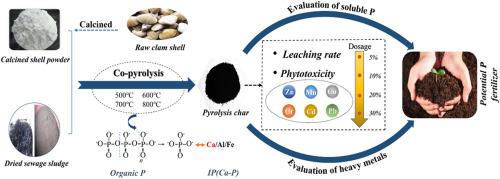Process Safety and Environmental Protection ( IF 6.9 ) Pub Date : 2021-10-11 , DOI: 10.1016/j.psep.2021.10.008 Ziyan Ren 1 , Wei Zeng 1 , Hongjun Liu 1 , Yuan Jia 1 , Xiaojing Peng 1 , Yongzhen Peng 1

|
Phosphorus is an indispensable element, while the existing phosphate rock resources are not enough to maintain the long-term demand of modern agricultural development. To ensure the sustainability of economic and social, it is necessary and urgent to seek the alternative phosphorus source of phosphate rock. In this study, calcined clam shell powder (CSP) was firstly used as a modifier and mixed with sewage sludge (SS) for co-pyrolysis to obtain sludge-derived pyrochars containing a large amount of bioavailable phosphorus. The effect of different temperatures (500, 600, 700, 800 °C) and dosages (0%, 10%, 20%, 30%) on the change in the form of phosphorus during the pyrolysis process were investigated. With the increase of temperature and the addition of CSP, the orthophosphate (Ortho-P) increased from 63.69% in the original SS to nearly 100%. Furthermore, the main phase of inorganic phosphorus (IP) changed, mainly in the form of apatite phosphorus (hydroxyapatite increased from 8.88% to 35.97%), and the concentration of easy-to-lose phosphorus reduced to 0.11 mg/g. After co-pyrolysis of SS with CSP, the passivation situation of heavy metals (HMs), such as Zn, Mn, Cr, Cu, Cd and Pb was significantly improved, thus reducing the potential environmental risk. The planting experiment proved that the sludge-derived pyrochars obtained by adding 20% CSP at 800 °C promoted the germination of seeds and the growth of seedlings. Consequently, the product of SS co-pyrolysis with CSP could be used as an excellently bioavailable and environmentally friendly phosphate fertilizer for agricultural production.
中文翻译:

通过煅烧蛤壳粉辅助热解提高污水污泥中磷的生物利用度
磷是不可缺少的元素,而现有的磷矿资源不足以维持现代农业发展的长期需求。为保证经济和社会的可持续性,寻求磷矿替代磷源是必要和紧迫的。本研究首先采用煅烧蛤壳粉(CSP)作为改性剂,与污水污泥(SS)混合共热解,获得含有大量生物可利用磷的污泥衍生的焦炭。研究了不同温度(500、600、700、800°C)和剂量(0%、10%、20%、30%)对热解过程中磷形态变化的影响。随着温度的升高和CSP的加入,正磷酸盐(Ortho-P)从原来SS的63.69%增加到接近100%。此外,无机磷(IP)的主相发生了变化,主要以磷灰石磷的形式存在(羟基磷灰石从8.88%增加到35.97%),易失磷浓度降低到0.11 mg/g。SS与CSP共热解后,Zn、Mn、Cr、Cu、Cd和Pb等重金属(HMs)的钝化状况得到显着改善,从而降低了潜在的环境风险。种植实验证明,在800℃下加入20%CSP得到的污泥衍生焦炭促进了种子的发芽和幼苗的生长。因此,SS与CSP共热解的产物可用作农业生产中具有极好的生物利用度和环境友好性的磷肥。磷主要以磷灰石形式存在(羟基磷灰石从8.88%增加到35.97%),易失磷浓度降低到0.11mg/g。SS与CSP共热解后,Zn、Mn、Cr、Cu、Cd和Pb等重金属(HMs)的钝化状况得到显着改善,从而降低了潜在的环境风险。种植实验证明,在800℃下加入20%CSP得到的污泥衍生焦炭促进了种子的发芽和幼苗的生长。因此,SS与CSP共热解的产物可用作农业生产中具有极好的生物利用度和环境友好性的磷肥。磷主要以磷灰石形式存在(羟基磷灰石从8.88%增加到35.97%),易失磷浓度降低到0.11mg/g。SS与CSP共热解后,Zn、Mn、Cr、Cu、Cd和Pb等重金属(HMs)的钝化状况得到显着改善,从而降低了潜在的环境风险。种植实验证明,在800℃下加入20%CSP得到的污泥衍生焦炭促进了种子的发芽和幼苗的生长。因此,SS与CSP共热解的产物可用作农业生产中具有极好的生物利用度和环境友好性的磷肥。Zn、Mn、Cr、Cu、Cd、Pb等重金属(HMs)的钝化状况得到显着改善,从而降低了潜在的环境风险。种植实验证明,在800℃下加入20%CSP得到的污泥衍生焦炭促进了种子的发芽和幼苗的生长。因此,SS与CSP共热解的产物可用作农业生产中具有极好的生物利用度和环境友好性的磷肥。Zn、Mn、Cr、Cu、Cd、Pb等重金属(HMs)的钝化状况得到显着改善,从而降低了潜在的环境风险。种植实验证明,在800℃下加入20%CSP得到的污泥衍生焦炭促进了种子的发芽和幼苗的生长。因此,SS与CSP共热解的产物可用作农业生产中具有极好的生物利用度和环境友好性的磷肥。











































 京公网安备 11010802027423号
京公网安备 11010802027423号